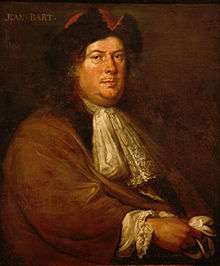Jean Bart
| Jean Bart | |
|---|---|
 Portrait by Mathieu Elias | |
| Born |
21 October 1650 Dunkirk |
| Died |
27 April 1702 (aged 51) Dunkirk |
| Piratical career | |
| Type | Dunkirk privateer |
| Allegiance | France/Dutch Republic/Mercenary |
| Years active | 1672-1697 |
| Rank | Admiral |
| Battles/wars |
Nine Years' War *Action of 29 June 1694 *Battle of Dogger Bank |
Jean Bart (21 October 1650 – 27 April 1702) was a French naval commander and privateer.
Early life
Jean Bart was born in Dunkirk in 1650[1] to a seafaring family, the son of a sailor who has been described variously as a fisherman[2] or corsair commander.[3] He almost certainly spoke Flemish, at that time the native language in the region, and his birth name was Jan Baert.[2][4][5]
Naval career
When he was young, Bart served in the Dutch navy under Admiral Michiel de Ruyter.[3] When war broke out between France and the United Provinces in 1672, he entered the French service. Since persons not of noble birth in those days couldn't obtain the rank of officer in the navy, he became captain of one of the Dunkirk privateers. In this capacity he displayed astonishing bravery, so that Louis XIV sent him on a special mission to the Mediterranean, where he gained great distinction.[6]
Unable to receive a command in the navy due to his low birth, he held an irregular sort of commission, but he had such success, however, that he became a lieutenant in 1679. He became a terror to the Dutch navy and a serious menace to the commerce of Holland. On one occasion, with six vessels, he broke through a blockading fleet, shattered a number of the enemy's ships, and convoyed a transport of grain safely into Dunkirk harbor.[6] He rose rapidly to the rank of captain and then to that of admiral.[7]
He achieved his greatest successes during the Nine Years' War (1688–1697).
- In 1689, in the beginning of this war he was captured by the English, together with Claude de Forbin, and taken to Plymouth. But 3 days later, they succeeded in escaping to Brittany in a rowboat, together with 20 other sailors.
- In 1691 he slipped through the blockade of Dunkirk, terrorizing the allied merchant fleet and burning a Scottish castle and four villages.
- In 1694 he achieved his greatest success in the Action of 29 June 1694, when he captured a huge convoy of Dutch grain ships, saving Paris from starvation. Jean Bart was raised into the nobility on 4 August 1694 with a peerage.
- In 1696 he struck another blow against the Dutch in the Battle of Dogger Bank (1696).
The Peace of Ryswick (1697) put a close to his active service.
Marriage and children
He married the 16-year-old Nicole Gontier on 3 February 1676. They had four children before Nicole died in 1682. Their oldest son, François-Cornil (17 June 1676- ?), became vice-admiral.
Then he married Jacoba Tugghe on 13 October 1689. They had ten children. He signed his marriage contract, which is still on file in Dunkirk, with the name "Jan Baert".
Jean Bart died of pleurisy and is buried in the Eglise Saint-Eloi in Dunkirk.
Legacy
Many anecdotes tell of the courage and bluntness of the 2.04 m tall, uncultivated sailor, who became a popular hero of the French Navy. He captured a total of 386 ships and also sank or burned a great number more. The town of Dunkirk has honoured his memory by erecting a statue and by naming a public square after him.
In World War II, 70% of Dunkirk was destroyed, but the statue survived.
 Statue of Jean Bart in Dunkirk
Statue of Jean Bart in Dunkirk Jean Bart as depicted in 1845
Jean Bart as depicted in 1845
Ships bearing the name Jean Bart
More than 27 ships of the French Navy, over a period of 200 years, have borne the name Jean Bart. These include:
- Jean Bart (1788) - 74-gun ship of the line
- Jean Bart (1811) - 74-gun ship of the line
- Jean Bart (1886) - First class cruiser of 4800 tonnes
- Jean Bart (1910) - 23,600 tonne battleship; the first French Dreadnought
- Jean Bart (1940) - 50,000 tonne battleship armed with 380mm guns. Although launched in 1940, the ship was not fitted out and completed until 1955, having spent much of World War II in dock at Casablanca; the last French battleship completed
- Jean Bart (1988) - Anti-aircraft frigate, still in service with the French Navy
Many smaller naval ships as well as privateers have also borne the name "Jean Bart".
Commercial products branded Jean Bart
- Jean Bart shoe polish
- Jean Barth Dutch cigarette tobacco
Jean Bart in popular culture
- Jean Bart appears as a character in the Baroque Cycle by Neal Stephenson.
- In the manga and anime One Piece a slave turned pirate is named after Jean Bart.
- The name Jean Bart is also a frequently used name for sea scouting groups.
- The book Het Eerste Litteken of Flemish writer Johan Ballegeer is an adaptation of Jan Baert's life story.
References
- ↑ "Baptismal record". Archived from the original on 29 April 2012. Retrieved 14 April 2012.
- 1 2 "Bart, or Baert, Jean". The American cyclopaedia. p. 343. Retrieved 3 June 2011.
- 1 2 "Bart, Jean". A Naval Encyclopædia. 1. L. R. Hamersly & co. 1880. p. 67. Retrieved 3 June 2011.
- ↑ De Vries, André (2007). Flanders: a cultural history. Oxford University Press. p. 273. ISBN 0-19-531493-X. Retrieved 3 June 2011.
- ↑ Guerin, Leon (1851). Histoire Maritime de France (in French). Paris: Dufour & Mulat. p. 479. OCLC 464444400. Retrieved 3 June 2011.
- 1 2

- ↑

External links
| Wikimedia Commons has media related to Jean Bart. |
- Site consacré uniquement à Jean Bart (in French)
- Jean Bart (in French)
- Jean Bart (in English)
